Paul Mitchell has become one of the most highly sought-after names in football for a certain select group of clubs that could avail of his services.
The 41-year-old Mancunian has announced that he’s going to leave his current club, Monaco, once they’ve got a replacement settled in and ready to assume his sporting director hot seat.
Mitchell has led a very interesting career to end up becoming such a well-known name and highly-rated figure at the top of the game.
A former midfielder, Mitchell’s playing career was cut short due to a bad injury that ultimately played a deciding factor in his decision to retire from playing at 27 years old.
Determined not to let that be the end of his story in football, Mitchell shifted his focus to excel in a different area of the game.
He became involved in the scouting side of things, taking on key roles at MK Dons, Southampton, Tottenham Hotspur, Red Bull international and then Monaco, with job titles ranging from Chief Scout to Head of Scouting to Technical Director to Sporting Director.
He’s credited with having played a key role in signings like the transfer of Bayern’s Sadio Mané to Southampton from RB Salzburg, Dele Alli from MK Dons to Tottenham and Heung-min Son from Bayer Leverkusen to Tottenham to name a few, while Mitchell is reported to have blossomed while working alongside former Manchester United manager Ralf Rangnick at Red Bull.
Now, Mitchell is being linked with the likes of Liverpool and, indeed, Manchester United in his own right, as he readies himself for his next challenge.
The “workaholic”, as described by former teammate Aaron Wilbraham in an April 2022 article from The Athletic, declared that he “completed [his] mission” with Les Monégasques when explaining his decision to leave the club, with one eye seemingly on a return to his native England where he’s said to be in hot demand, per a recent report by L’Équipe.
On that note, this piece is going to have a little look into Mitchell’s Monaco mission and lay out exactly what he was responsible for and what he achieved with Les Monégasques.
With the help of relevant data and statistics, we’ll provide an analysis of the Ligue 1 club’s transformation and journey with Mitchell.
Our data analysis will focus on three distinct areas which will act as our three sections in this piece, two of which are more specific requirements of his job in Monaco and one of which is a more overarching requirement.
Without further adieu, let’s crack on with the analysis!
Paul Mitchell Tactics & Formations
Initially, on joining Monaco, Mitchell conducted a review of the club to analyse where they needed improvement.
He came to the conclusion that a full-on rebuild was necessary, which can’t have been overly pleasing to the ears of his bosses but, at the same time, perhaps provided an indication of the thorough nature of this sporting director’s work.
He was given a lot of responsibility with this rebuild, starting by replacing head coach Robert Moreno with former Bayern boss Niko Kovač before tackling the playing squad and trimming it down.
Securing the right head coach was key for the project, as Mitchell and this figure had to be somewhat aligned on their view of the game in order to ensure the types of players coming in were ones that could be used to their full potential within Monaco’s system, while also helping to ensure Mitchell and his team were looking at the right types of players.
With the “aggressive” and “active” vision of Kovač, former Monaco CEO Oleg Petrov explained that Mitchell saw someone who endorsed a “trendy” and “modern” style of play that appealed to him.
With that part of the job done, trimming the first team squad became paramount.
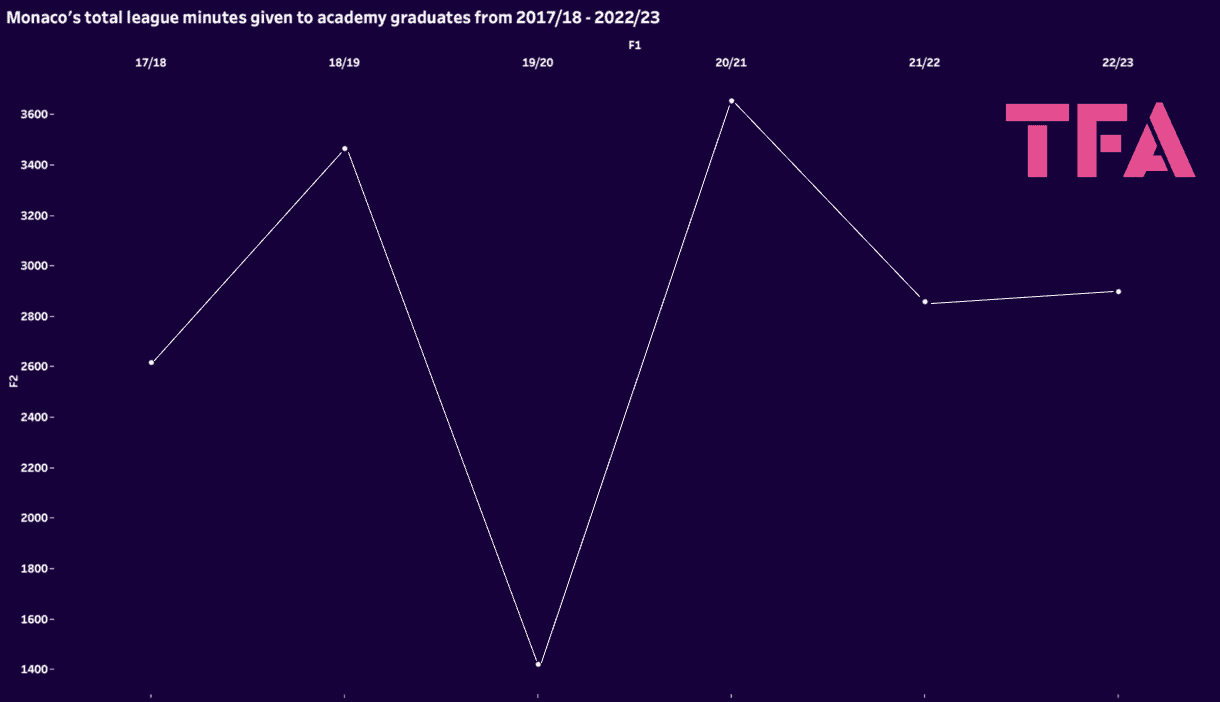
In 2017/18, 32 different players featured for Monaco in Ligue 1.
In 2018/19, that number rose to a whopping 42 players, while 28 featured in the pandemic-curtailed 2019/20 campaign.
Mitchell joined for the 2020/21 season and from then on, Monaco’s total number of players featured in the league over a season were: 29 in 2020/21, 27 in 2021/22 and 27 in 2022/23 (so far).
So, a notable drop from the pre-pandemic numbers.
Mitchell is reported to have played a leading role in the slashing of the number of professional playing contracts at the club from 77 to 39 quite quickly, further highlighting the need to trim the squad on his arrival.
A key part of this squad building and planning role was making greater use of the club’s ‘La Diagonale’ training centre.
In 2017/18, 2617 league minutes were played by Monaco academy graduates in the club’s first team.
In 2018/19, this rose to 3465 but in 2019/20, the season before Mitchell’s arrival, it dropped to 1421.
Additionally, these numbers were shared between: five of Monaco’s 32 players in the league in 2017/18 (15%), nine of 42 in 2018/19 (21%) and two of 28 in 2019/20 (7%).
In Mitchell’s first season at the club, Monaco peaked on the number of league minutes for academy graduates over the last six seasons, hitting 3654.
This dropped to 2858 in 2020/21 but has already risen this season, which is yet to be completed, to 2898 and counting.
These numbers were shared between: five of Monaco’s 29 players in 2020/21 (17%), seven of 27 in 2021/22 (25%) and seven of 27 again (25%) in 2022/23.
So, not only have more league minutes been played in total by Monaco’s academy graduates since Mitchell’s arrival compared to the seasons directly preceding his arrival, but a higher percentage of the first-team squad has been comprised of academy graduates as well, with only one of the three campaigns preceding Mitchell’s arrival (2018/19) boasting a higher percentage of squad members coming from the academy than the lowest percentage to have occurred in any of Mitchell’s campaigns at the club (2020/21).
Per a recent CIES study, Monaco have given 8.6% of the team’s overall playing time in 2022/23 to club-trained players.
This ranks 42 out of the 98 clubs in Europe’s top-five leagues, while this also places Monaco ninth in this particular area among their French rivals.
So, while not outstanding and there is certainly some room for improvement for Les Monégasques in this regard, they are definitely not faring badly when it comes to incorporating academy products into the first team setup at present.
Monaco’s academy has always been of high quality.
In 2015, CIES released a study showing that Monaco’s academy was one of the most fruitful in Europe, with an average of 64.8% minutes played by 20 players around Europe to have been trained in their academy.
However, just one of those 20 players was still plying their trade with Les Monégasques when this study was conducted.
It’s clear Monaco take pride in their academy but under Mitchell, they’ve done a better job of creating a clearer pathway from La Diagonale to the first team.
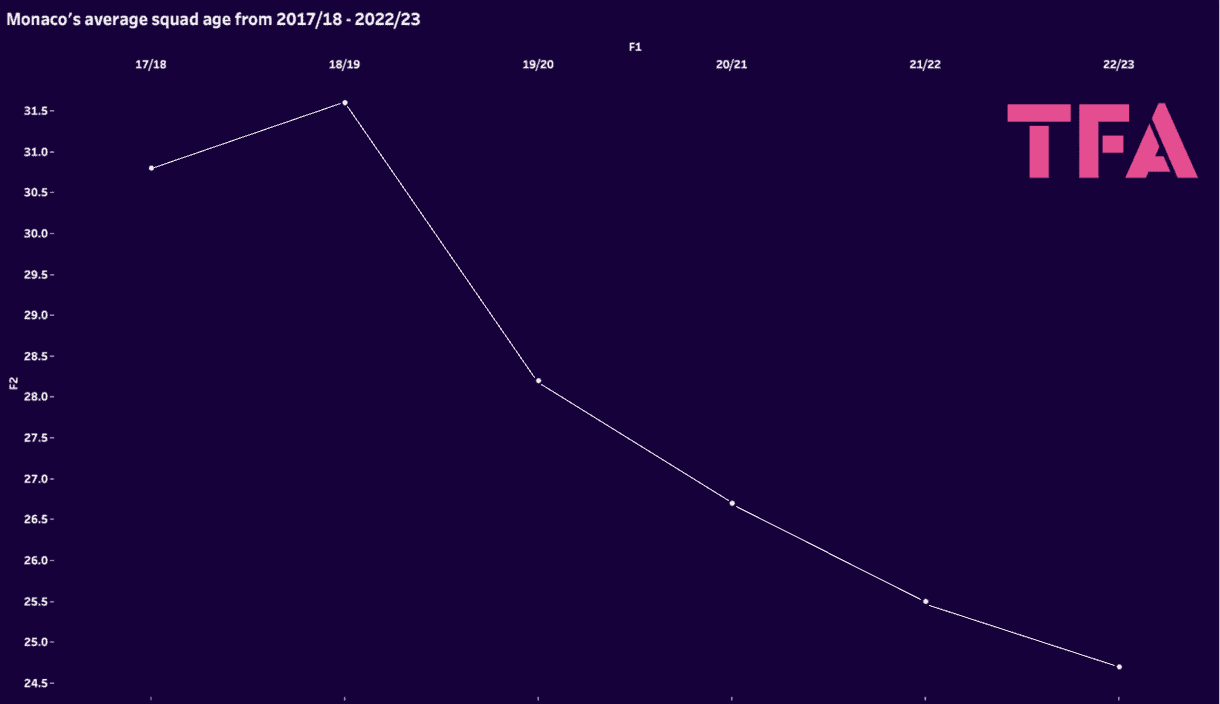
The utilisation of club-trained players generally correlates with a lower average squad age and this is also something we’ve seen with Monaco since Mitchell arrived.
From 2017/18 to 2019/20, Monaco’s average squad age was 30.8 (seventh-youngest in Ligue 1), 31.6 (fourth-oldest in Ligue 1) and 28.2 (fourth-youngest in Ligue 1), respectively.
Since Mitchell’s arrival, this has dropped drastically, hitting 26.7 in 2020/21 (third-youngest in Ligue 1), 25.5 in 2021/22 (second-youngest in Ligue 1) and 24.7 this season — the youngest squad in France’s top flight.
Of course, though, it’s not just incorporating the academy more that’s achieving this, but also Mitchell’s approach in the transfer market.
Monaco Transfer market activity
Naturally, player recruitment is a massive part of Mitchell’s role that will certainly interest a lot of those reading this article.
It’s a part of the game that I personally find very interesting, as I’m sure plenty of you do too.
Explaining his approach to transfer activity, Mitchell explained to The Athletic:
“we’re data-informed, not data-led… We look for scouting profiles to suit the type of style we want to play, and then we look to recruit into that style.
The profiles have to have certain characteristics; we build a KPI map for every position relevant to our style.”
Going back to his pleasure with Kovač as explained earlier in the article, we know Mitchell wanted a coach who endorsed a high-octane, aggressive, active style of play.
He wanted to see Monaco players putting in big physical shifts out on the pitch and recruited to that vision, focusing on bringing in young players with good technical quality and also a capacity to put in the hard yards on and off the ball every game and ensure the manager’s physical standards were met.
This would explain the targeting of players like Myron Boadu, Ismail Jakobs, Mohamed Camara and Krépin Diatta — all U23 players when signed by Mitchell’s Monaco with the potential to fit the bill when it comes to the club’s perceived playing blueprint.
The key roles played by the likes of Aurélien Tchouaméni and Youssouf Fofana in the middle of the park, both young central midfielders with a lot of promise and a lot of energy to give, along with Benoît Badiashile at the back all fit this same mould.
Tchouaméni (now with Real Madrid) and Badiashile (now with Chelsea) have since shot to global stardom, a result of their own talent and hard work, of course, but also thanks to the Monaco system in which they fit so well and were able to shine.
So, Mitchell, his recruitment team and the coaching staff clearly created a clear identity for their squad, broke down each part into quantifiable KPIs (key performance indicators) and recruited to those profiles very effectively.
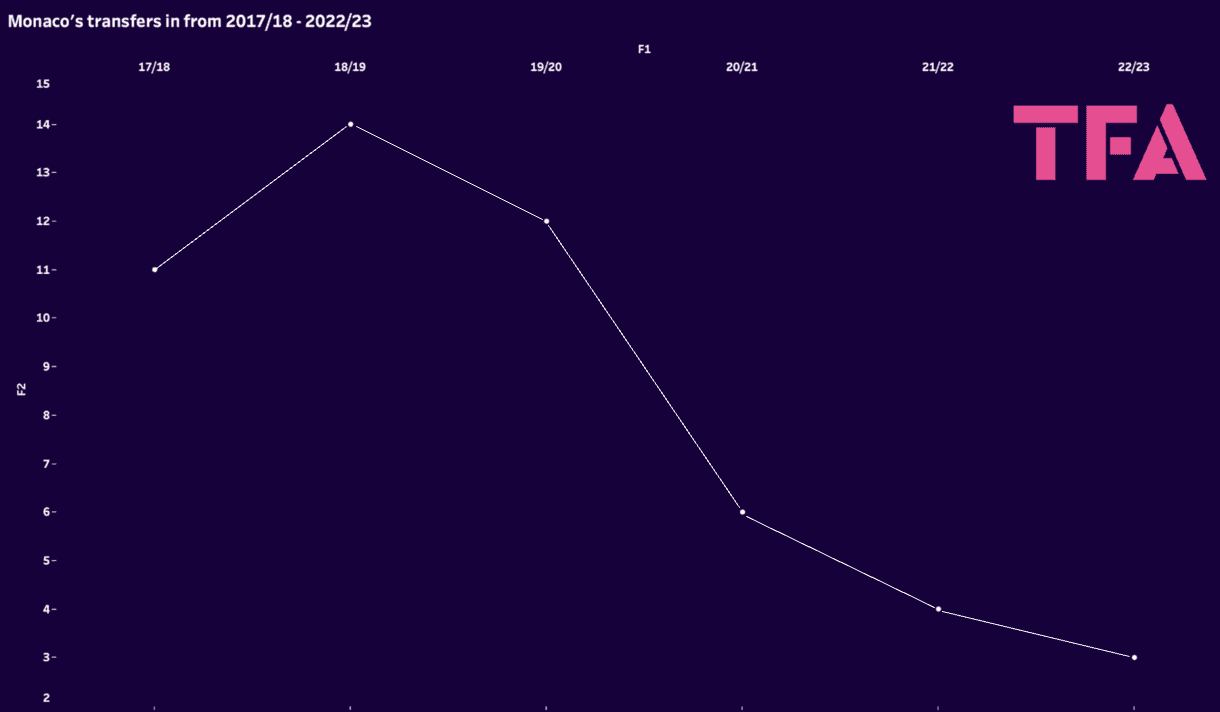
This wasn’t just effective at recruiting players that fit the style of play and with the right profile but also helped narrow down the number of players that were coming through the doors at Stade Louis II year after year.
In the three seasons prior to Mitchell’s arrival, Monaco made 11, 14 and 12 permanent signings in each respective season.
This equates to 37 signings over three seasons and a whopping €468.25m splashed on new players in that time.
Under Mitchell, the number of signings significantly dropped.
It was all about quality over quantity and the systems they’d put in place in terms of their recruitment as previously discussed helped ensure they managed to get as much quality as possible into the club without needing to sign in bulk and hope some would come good.
They could instead recruit more selectively and actually get more benefit as they managed to sign players that fit the club and their style well without bloating the squad, disrupting the team’s harmony and creating a problem for the future — like the one Mitchell and his team had to solve when they arrived in Monaco.
In three seasons and six transfer windows with Mitchell, Monaco signed six, four and three players permanently, equating to 13 players through the doors — just over a third of those signed in the three seasons before the Englishman’s arrival in Ligue 1 — and €141.7m on transfer fees, which is three times less than they’d spent in the same period before Mitchell joined.
All in all, their approach to the transfer market has been far more efficient and sustainable with Mitchell involved.
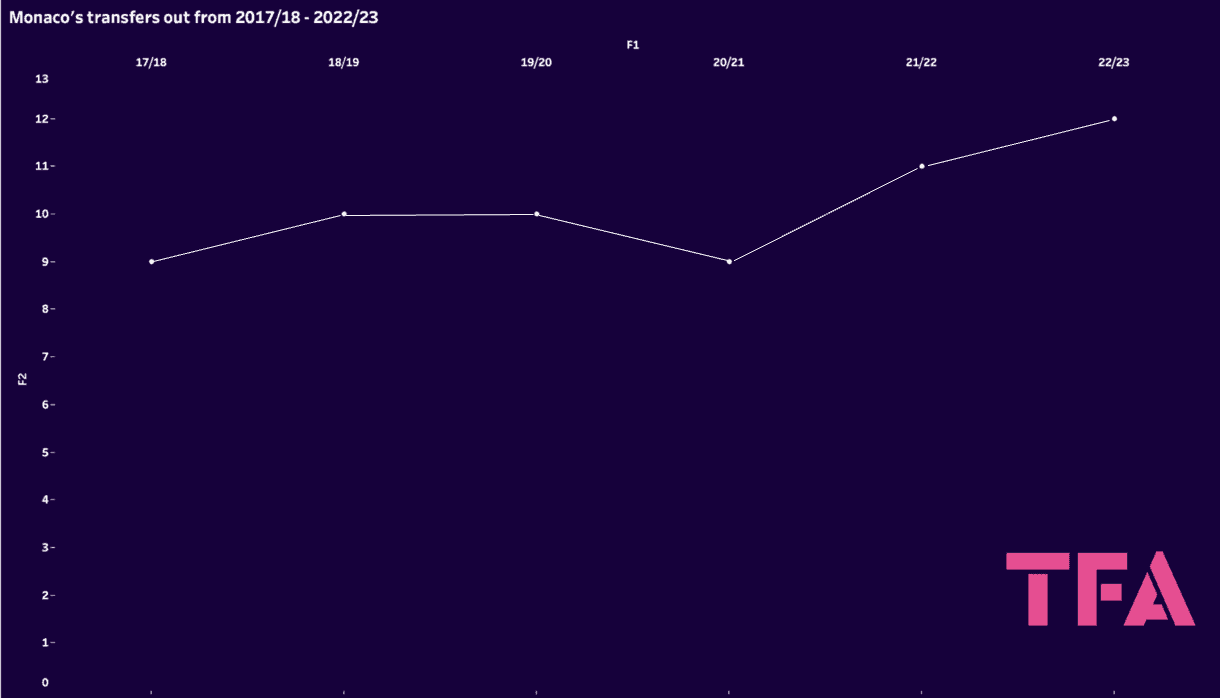
In terms of outgoings, Monaco permanently sold nine, 10 and 10 in the three seasons preceding Mitchell’s arrival, with that totalling a very healthy €650.5m.
In Mitchell’s three seasons at the club, they’ve sold nine, 11 and 12 players, respectively, totalling €205.17m in transfer fees.
While Mitchell’s tenure has seen Monaco recoup less from transfer fees, they are still in a healthy profit for the three-year period, thanks in no small part to the sale of Tchouaméni last summer.
All of this provides important context to the situation Monaco were in when Mitchell arrived — they had just gone through a big squad overhaul, probably had too much money and not enough of a plan for how to use it and took on a fairly scattergun approach to surmise it from the outside.
Of course, recruitment in football is difficult and complex, and it’s easy for me to look at it retrospectively from the outside and criticise those at Monaco before.
However, it’s clear Mitchell had a more measured approach that’s made something very difficult look easier than it actually is — a testament to his quality in the role.
Stabilisation
Our final section will look at the more overarching goal of Mitchell at Monaco, which was achieving stabilisation for the club.
It’s football and at the end of the day, results on the pitch and points on the board are what really count; everything else is simply a means to bettering this, whether it’s intelligent recruitment or innovative tactics.
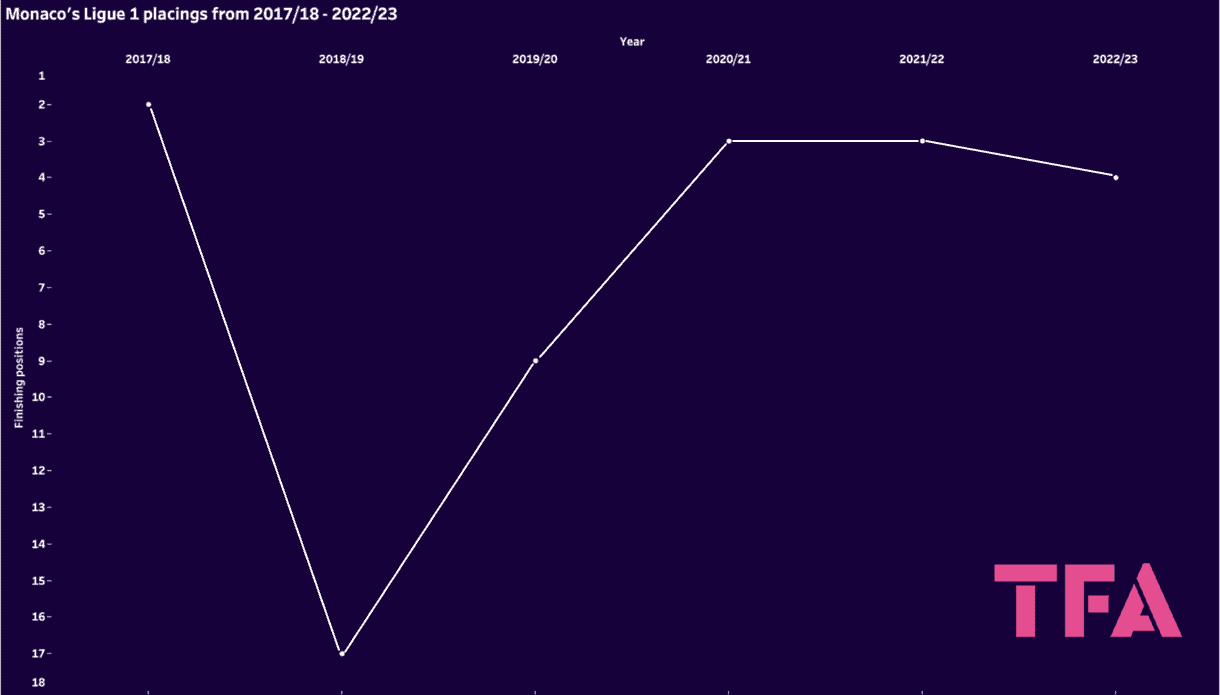
In the three seasons before Mitchell’s arrival, Monaco found themselves floundering a bit.
They went from second in 2017/18 — a season after they’d won the league in 2016/17 — to 17th in 2018/19 — a dramatic decline resulting from the gutting of their squad and failure to rebuild effectively.
They climbed to ninth the following season, which is a more respectable finish but still not where Les Monégasques see themselves in the French football landscape.
In three seasons with Mitchell on board, Monaco have twice finished in third and currently sit fourth, three points off third and that last Ligue 1 UEFA Champions League spot.
This is much more like it for the eight-time Ligue 1 champions and 2003/04 Champions League runners-up.
They don’t expect to be winning the league every year, certainly not with PSG around in their current state.
But they expect to be right there among the best of the rest, routinely securing Champions League qualification.
With Mitchell, that’s what they’ve achieved.
Everything we discussed in the previous sections of this analysis led to this end result — improved league finishes and back-to-back Champions League appearances, with another next season firmly on the cards if they can finish 2022/23 strong.
Conclusion
So, if Mitchell has “completed his mission” at Monaco, that could be interpreted as him saying he has successfully helped the club to turn around what looked like a disastrous turn in form and fortune, and firmly plant the club back among the top of the Ligue 1 hierarchy.
Intelligent recruitment, a clear strategy and vision, good planning and organisation have been key to achieving this, as has Mitchell’s famous work ethic, I’m sure.
Wherever the Mancunian sporting director goes next, he comes with a proven track record of success and experience of delivering when the chips are down, which is surely going to be exciting and invigorating for his next club.

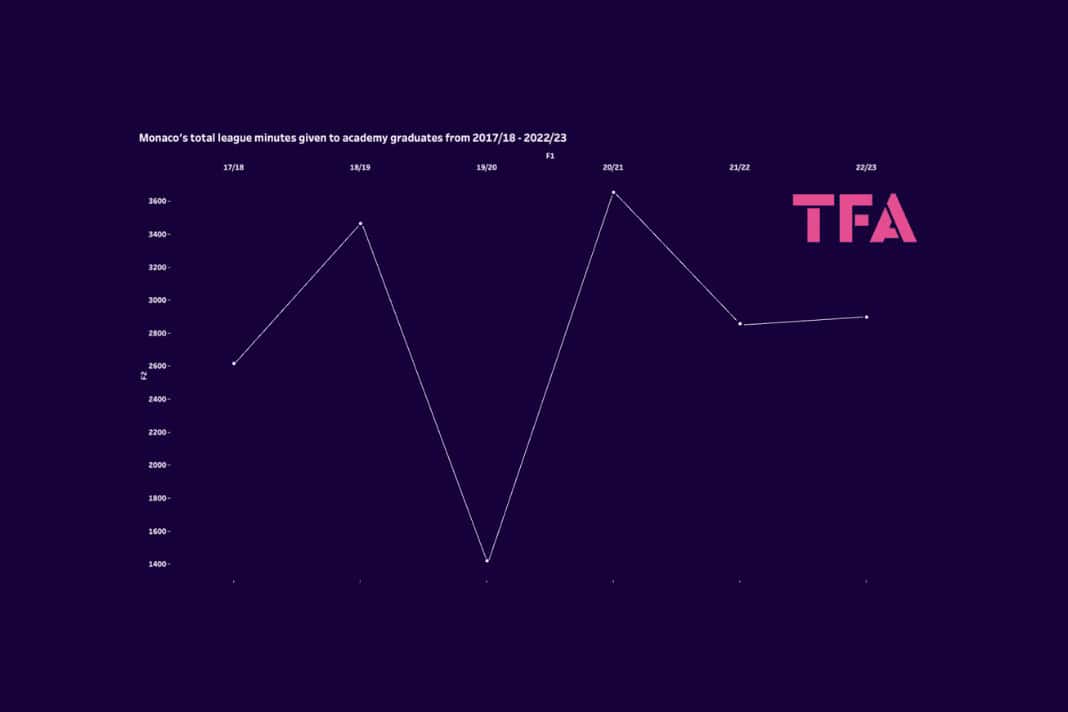



Comments